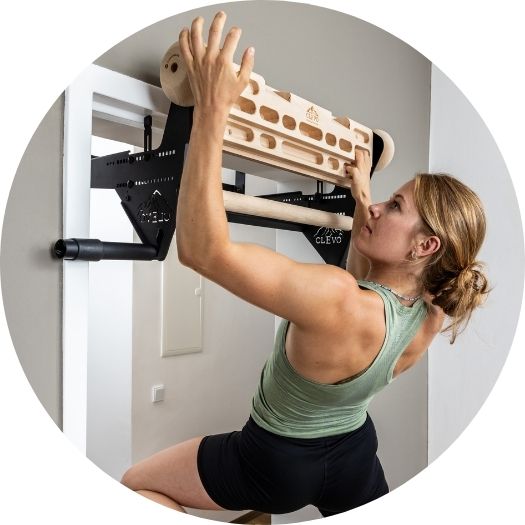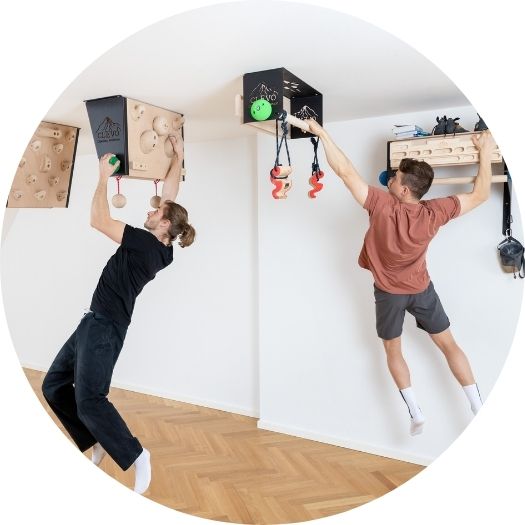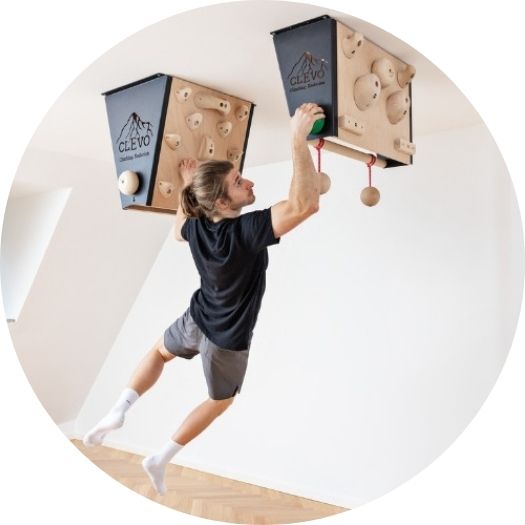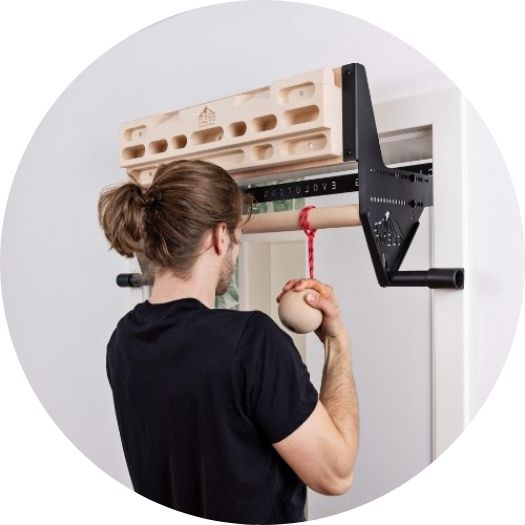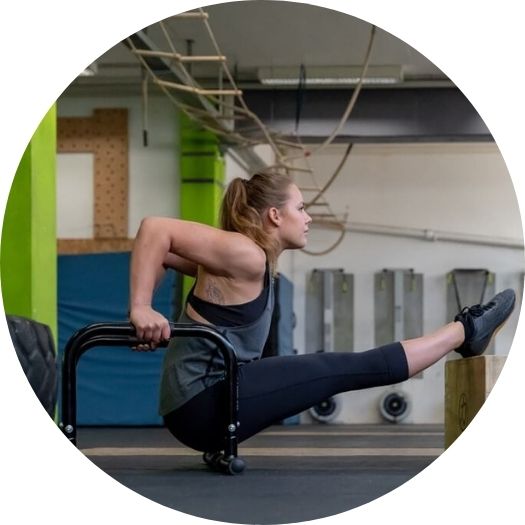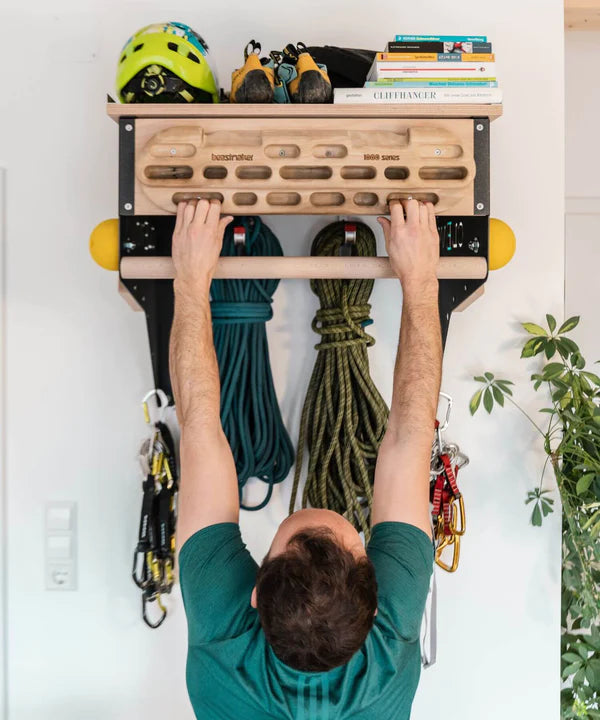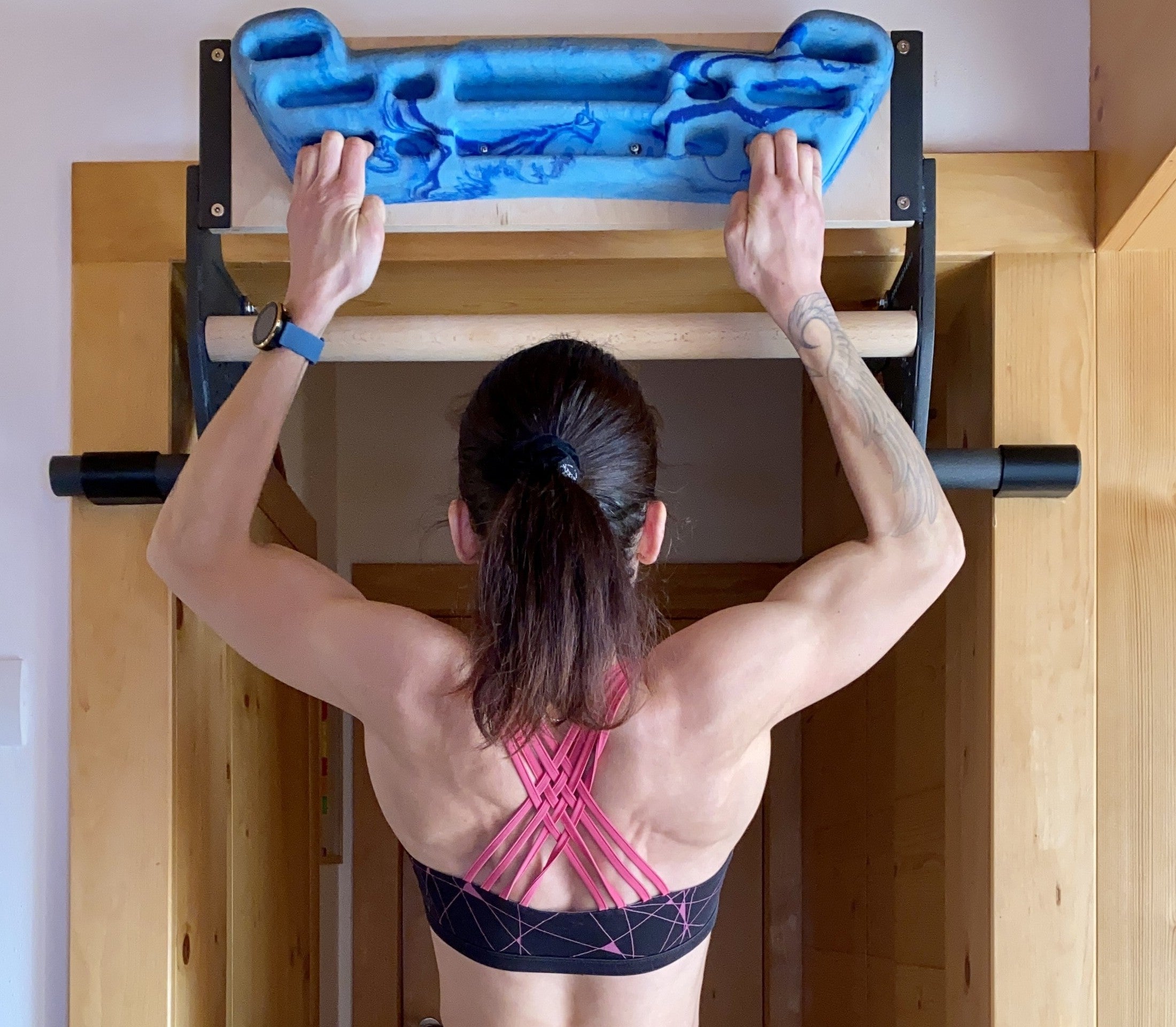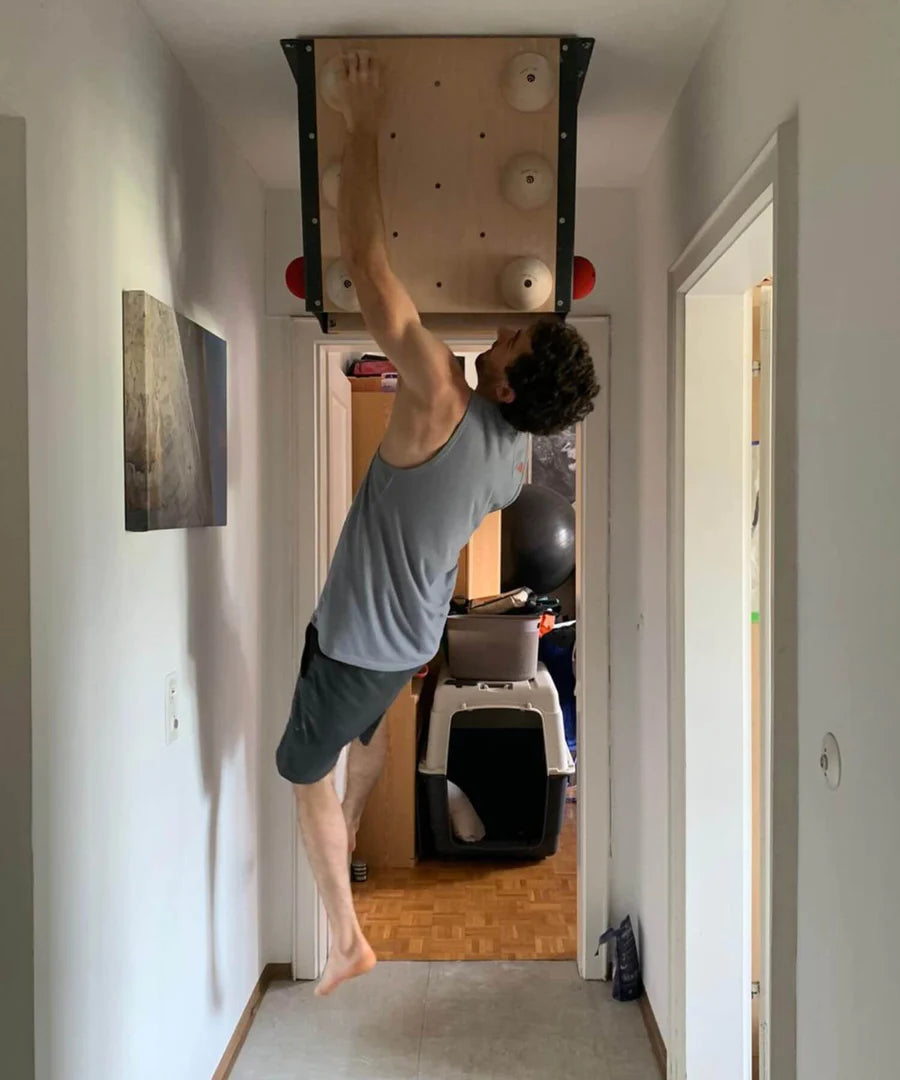Although there are some big differences between climbing and bouldering, many climbing training equipment are useful for both climbers and boulderers. This blog post is about exactly these training equipment, with which you can efficiently train your skills for both sports.
The special equipment for climbing training make your workout at home and on the road a lot easier, because you don't need the rocks for climbing or the wall for bouldering. Instead, you can train with the smallest equipment and thus lay the best foundations for climbing and bouldering. Especially for training muscles, technique and grip strength, there is a lot of useful equipment - just read through our article!
Hangboards and climbing holds: Rarely has climbing-specific training been so efficient!
Whether climbing or bouldering: The grip surfaces in nature and in bouldering gyms are structured differently. Sometimes you have a large and comfortable grip surface that you can comfortably wrap your entire hand around to pull yourself up. Other times, you can't even begin to talk about such comfortable grip conditions, because the next grip point is so small that you can only hold on with the tips of two fingers and pull yourself up from there. Thus, finger training comes into focus as an important skill trainingfor climbing and bouldering.
If you think that only climbing or bouldering on the routes will prepare you optimally for the different grip conditions, you are mistaken. It is important to train the specific skills on hangboards and holds in order to then be able to deliver on the spot on the route - that is, when it matters. Hangboards convince as THE accessory for climbing training!

Hangboards are modules that are built in such a way that you have little gripping surface and can either only hold on with your fingertips or with a maximum of half of your fingers. Fingerboards have different surfaces on which you can train various grip constellations with your fingers. With regular practice, you'll gradually eradicate your weaknesses and gain ultimate finger strength! Once you are satisfied with your progress, you can switch to mobile fingerboards, which are quite unstable and thus increase the intensity of finger training.
Other equipment that can be used to train your finger strength are various climbing holds which you can attach individually to your climbing wall or to your climbing module (for "climbing module" see next section). The more climbing holds you have at home, the more you can change the routes on your climbing wall or climbing module to make your training more varied.
Speaking of variety, climbing balls also contribute to variety. Climbing balls are not suitable for climbing-specific training. You don't have to do the kind of grip that climbing balls require when you're climbing or bouldering. So why should you buy grip balls as an accessory for climbing training at all?
Because they help you with the strength training of your forearm muscles and as climbing equipment make your training more varied! As you know: variety keeps you happy!
Climbing walls and climbing modules: A base that provides many possibilities!

A hangboard is a sensible purchase, especially for finger training, but to be able to fully prepare for climbing or bouldering, you need something "bigger". That's exactly what climbing walls and climbing modules are: Both are relatively large building blocks that you can hang, for example, on the door, on the ceiling ceiling or on the wall.
Especially the wall-mounted modules provide you with various possibilities, as they have a high load-bearing capacity and can accommodate many climbing holds. In addition, it is possible to attach the fingerboards already described to the modules, which makes your training even more versatile.
Climbing walls and climbing modules for home are the small versions of the large climbing walls in bouldering halls. The fact that you can mount the holds as you wish and thus vary the routes gives you the opportunity to adapt your own routes at home to your level and to set new stimuli at certain intervals.
Climbing training equipment for strength training: Because with more strength, many things are easier!
Although climbing and bouldering are sports in which strength is not the primary factor and muscular people are generally at a disadvantage when climbing due to their high body weight, strength training is a useful addition to climbing. With the right climbing training equipment, it is possible for you to train your strength specifically so that it benefits you when climbing and bouldering.
A pretty small climbing training accessory that you can carry with you at all times and with which you can train your grip strength even in the office in an unobtrusive way is the finger trainer. Especially if you don't have enough strength to hold onto the hangboard with your fingers yet, the finger trainer is an ideal companion for the first steps of your training.

A pretty powerful climbing training accessory: gymnastic rings. The gymnastic rings made of wood from Pullup & Dip can be attached in several places and are therefore flexible in use. Training on rings provides a special training stimulus, which is excellent for climbing and bouldering. Due to the instability of the rings, you train significantly more muscle groups in combination, because you rely on enormous body tension to compensate for the instability of the rings. Especially the deep muscles are outstandingly challenged by training on rings. In addition, the rings are perfect for training the traction muscles that are important for climbing and bouldering. If you train for a few weeks under the unstable and extremely heavy conditions on rings, you will later notice how much easier many movements suddenly become for you when climbing and bouldering.

Now to the pull-up bar, which is a controversial accessory for climbing training among climbers and boulderers: With a pull-up bar you train pulling movements and the muscles that are important for climbing, but the pull-up bar is not enough to prepare you for the complex and much more versatile demands of climbing. Why a pull-up bar is still a good climbing training accessory? You can hang onto the pull-up bar and creatively put together a climbing-specific workout without any problems! On the one hand, the grip variations help you to get a climbing-specific workout, on the other hand, you can pull yourself up with one arm more than the other and thus also recreate climbing-like conditions. In addition, you can train your strength extremely intensively with one-arm pull-ups, which are an absolute supreme discipline.

In addition to pulling exercises, we recommend that you also integrate pressing exercises into your workout. The shoulder, triceps and chest muscles are often underdeveloped due to the low demands of climbing and bouldering. For reasons of visual aesthetics and because, especially in bouldering, there are sometimes routes where pressure forces must be applied, equipment for climbing training of the shoulder, triceps and chest muscles are a good idea. Here we can recommend Parallettes; especially the wooden mini-bars with ergonomic handle from Pullup & Dip are good equipment. With Parallettes, exercises such as dips and push-ups can be trained under better conditions. In addition, a comprehensive training of body tension is possible.
Magnesia: Improves grip strength. Optimal for climbing and bouldering.
Regardless of whether as climbing training equipment or for the moment in the bouldering hall when it comes down to it on the routes: Magnesia optimize grip strength - and incredibly effectively!
When using magnesia on climbing routes in nature, you have to be careful, because it may be forbidden to use magnesia for nature conservation reasons. Still, it's worth having the chalk with you because it makes all the difference in your favor when climbing and bouldering in particularly challenging spots by making it easier for you to hold on. Especially in bouldering, where many routes consist of flat or rounded holds, good grip strength is crucial.
.

An all-rounder that can always be used is liquid chalk, also called "liquid chalk". The liquid chalk from Pullup & Dip is particularly productive, because even a small dab of the chalk on the palm of the hand is enough to have a noticeable improvement in grip strength during several routes. In addition, the liquid chalk is easily portable.

It's a little more complicated with non-liquid chalk: in fact, some bouldering halls only allow the use of liquid chalk to reduce the formation of fine dust. For those who climb outdoors or spend their time in bouldering gyms where powder ch alk is allowed, the Chalkball from Pullup & Dip is an excellent product. The Chalkball dispenses the chalk sparingly, so you get the maximum benefit from the chalk! In addition to the chalk ball, you should purchase the matching chalk bag as a carrying bag.
Conclusion: Find your favorite and individual climbing training equipment!
There are many options and numerous climbing equipment to complement your climbing training. If you train solely on your climbing routes, you will definitely not develop your climbing skills efficiently. This is because on climbing routes you spend a lot of strength, endurance and concentration on things you are already good at.
The most efficient way to train is to use specific climbing equipment to target your weaknesses; you won't be able to do this without climbing equipment. So ask yourself what your weakness is: Do you need more strength in your fingers? Or do you notice on particular routes that a little more strength in the triceps and shoulder muscles would actually be beneficial?
Find your climbing equipment for targeted training! Our numerous suggestions will give you several ideas on how to find the right climbing training equipment depending on your preferences and goals, and how to use them to develop your skills. Now it's your turn: find the right climbing equipment and improve your skills - from finger strength and grip strength to body tension and climbing technique!

